"Tripod, with fillets streaming out l. and r., on which are ravens r. and l., and in centre, dolphin over wreath ('exuviae' of Apollo for 'pulvinar' of Apollo and Diana ?)"
Harold Mattingly,
Coins of the Roman Empire in the British Museum, Vol. II, London, 1966
"Tripod on which are ravens: a, dolphin." [sic]
Harold Mattingly and Edward A. Sydenham,
The Roman Imperial Coinage, Vol. II, London, 1926.
"Tripod with fillets; above, ravens, l. and r., and dolphin over wreath."
I.A. Carradice and T.V. Buttrey,
The Roman Imperial Coinage, Vol. II Part 1, 2nd rev.ed., London, 2007.
"Ravens on tripod, dolphin above."
H.A. Seaby,
Roman Silver Coins, Vol. II, London, 1968
rara temporum felicicitate, ubi sentire, quae velis, et, quae sentias, dicere licet.
One of the rare joys of our times, you can think whatever you want and then say whatever you think.
Tacitus, Histories, i.i.
 HAT JUMPS OUT at you here right away?
HAT JUMPS OUT at you here right away?
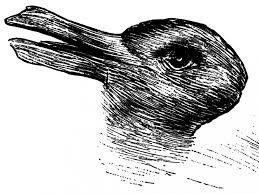
At first glance do you see a left-facing duck or a right-facing rabbit? Keep this optical illusion in mind as I wrap up my four-part series today.
Once upon a time Ian Carradice suggested to me in an email that more work needed to be done on Titus's pulvinaria coinage. This seemed out of my scope of interest, since I am exclusively interested in the reign of Titus's brother Domitian. However it did occur to me that the reverses for Domitian's first commemorative issue in 81 A.D. had been purposefully selected and that several of Titus's reverses had been excluded from this particular issue. So the question I have undertaken is, why these reverses in particular? Here again are the four coins we have been looking at, RIC 1, RIC 2, RIC 3 var, and RIC 5--
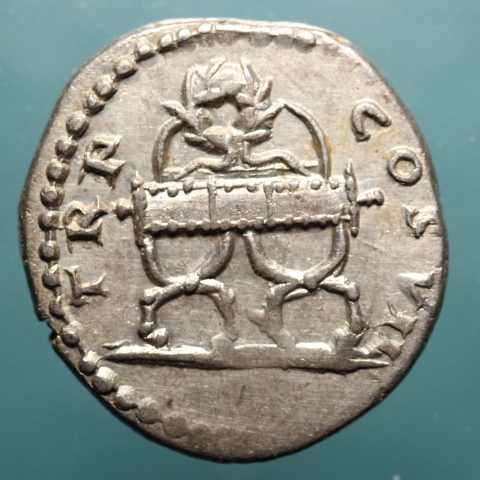

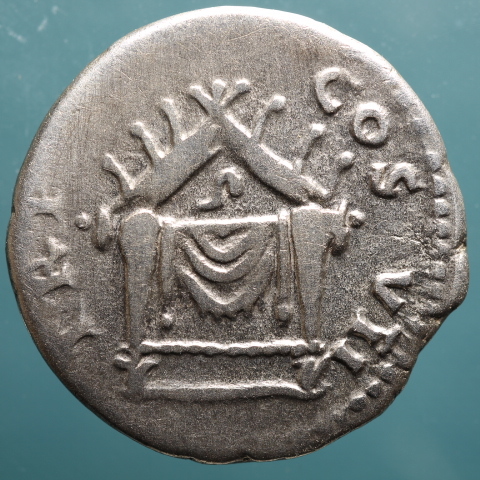
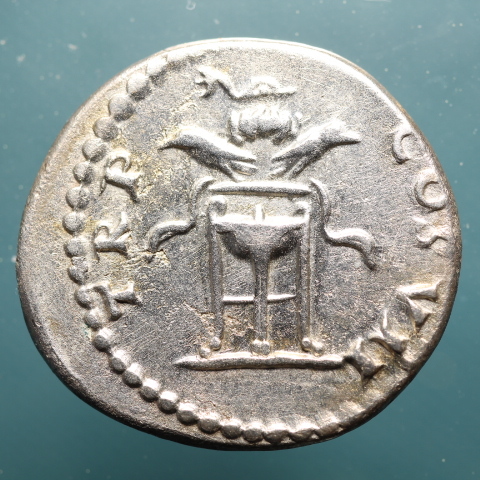
The articles about the first three coins on the left can be found on the Archives page of this website. Today I will examine the coin on the far right, RIC 5--
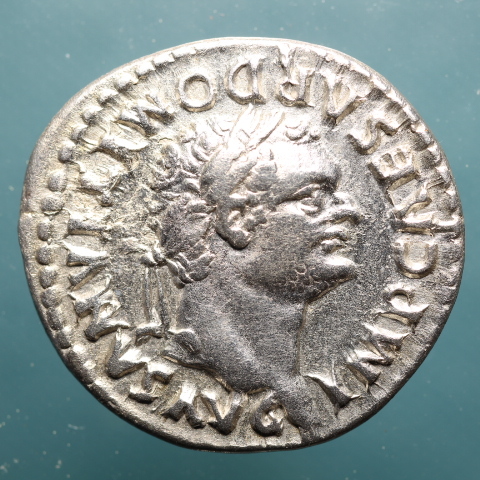

The god Apollo was born on Delos and was kept captive there as an infant. One day he turned himself into a dolphin and made his escape by swimming away. Apollo's sacred tree was the bay laurel. Later in his godly career he became irritated by the lack of diligence exhibited by a certain little white bird, the raven; in his anger he turned the bird's feathers from white to black. Let me think, is that everything? Oh yes, tripods were sometimes given as prizes at games dedicated to Apollo (and to other gods as well).
Once again, not a pulvinar (because there's no couch), but this coin has been identified with Apollo nevertheless, because on the reverse we see a dolphin, a wreath shown sideways, a pair of ravens, and a tripod, together amounting to a list of some of the secondary attributes of that god. "Something to do with Apollo" is not an unreasonable identification, not a pulvinar, according to Mattingly, but exuviae of Apollo specifically. Of course, both the dolphin and the tripod (while acknowledging the rather famous Delphic tripod coveted by Hercules) could apply to Neptune and Bacchus also, and the laurel wreath, while Apollo-specific in a divine sense (assuming it's laurel and not something else: olive, oak, seaweed or ivy, to name only a few possibilities), had another secular use, which I will talk about shortly. Looking at these items, it makes a person wonder why Apollo's two principal identifying attributes, the lyre and the bow and arrow, are both missing. And why is the wreath, in a complete departure from anything we've ever seen before, shown sideways. And why are there a pair of ravens instead of only the famous one from the myth?
I think we need to re-examine the items on the back of this coin to see if our current assumptions correct. First the dolphin and the tripod. We find both of these attributes, if that's what they are, on another reverse in the pulvinaria series. For comparison here are two examples of that reverse from the Hazelton coll. (RIC 74 and RIC 102), next to the RIC 5 for comparison--
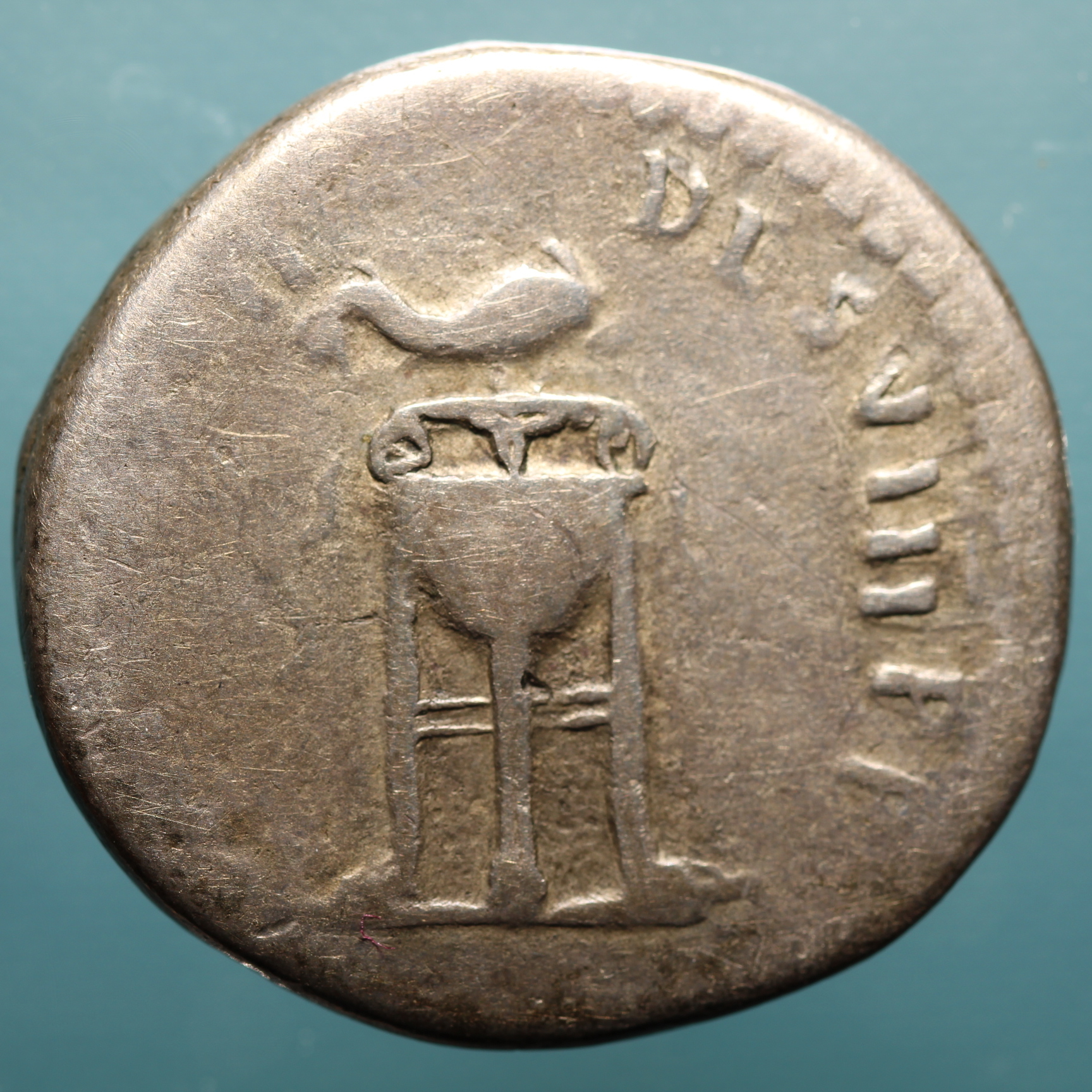
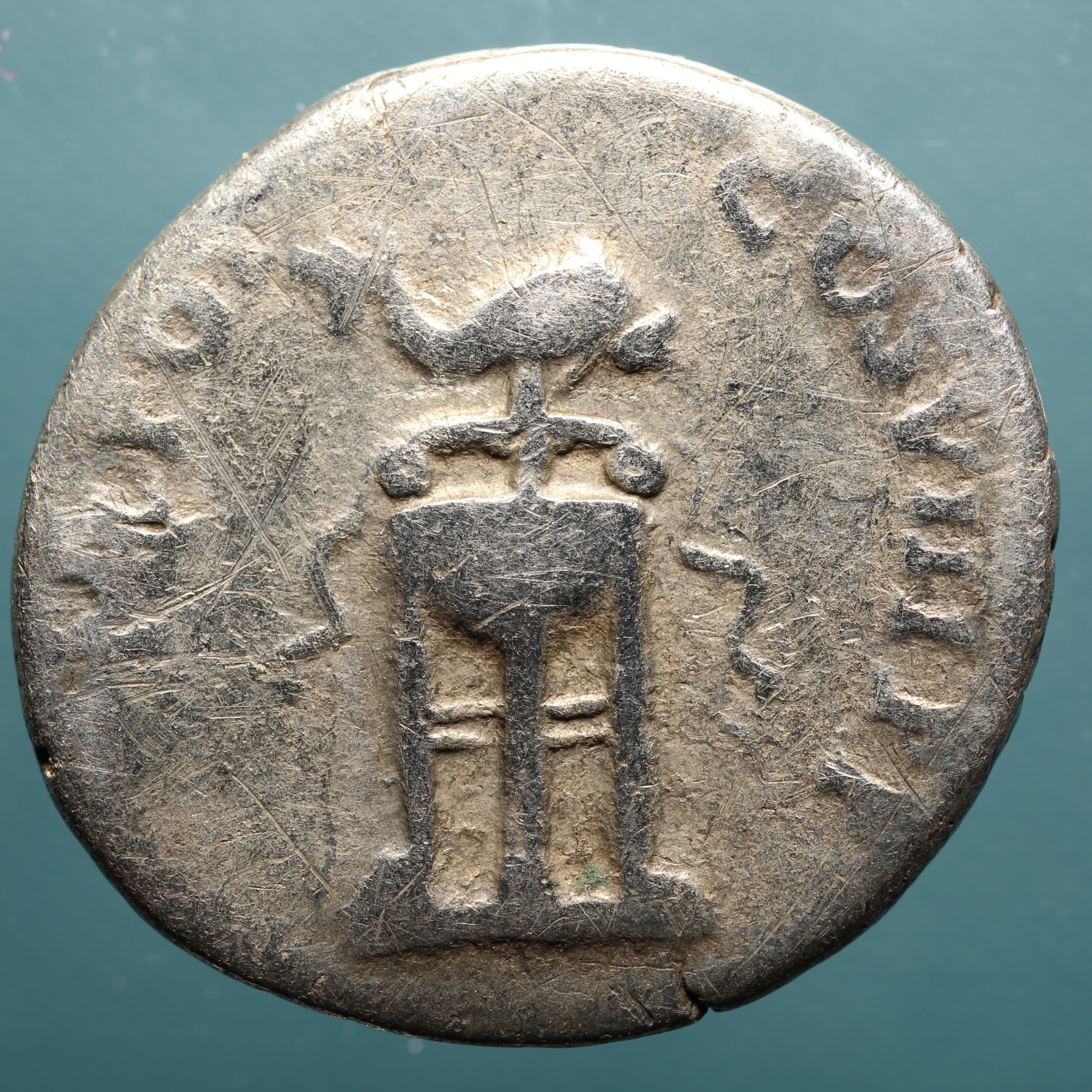

Despite small differences in the rendition, it appears to be the same tripod and dolphin on all three coins. In my opinion, this isn't any old dolphin and any old tripod. I believe that together the dolphin and the tripod are indeed one inseparable unit. Together they refer to a specific piece of temple furniture that would have been familiar to the Roman people--on the middle coin especially, the dolphin actually appears to be attached to the tripod in some fashion, perhaps on a hinge of some sort. In my opinion, the dolphin and tripod reverse on these coins represent a particular and well-known three-legged, incense-burning brazier. I suggest that it was located in the Temple of Apollo, not in the one in the Roman Forum but in the newer temple on the Palatine Hill. This temple was decreed by the first emperor Augustus on a spot struck by lightning. The reason for my choice of locus will become apparent in a moment.
Next let's talk about the laurel wreath, its use reserved by the Romans for emperors exclusively. Other wreaths were worn by other people for many reasons, but only emperors wore the corona laurea. The leaf of the bay laurel is pretty indestructible. Anyone who has tried to eat one in a bowl of soup can tell you that. But I don't imagine a wreath made of them would last forever. In fact, I should think it would need to be replaced from time to time, probably annually. And then the question arises, what do you do with the old one? Throw it on the trash pile? Toss it down the nearest latrine? Probably not. It stands to reason that there must have been a public ceremony to mark its replacement, involving a dignified, possibly even sacred, burning. With the heavy dolphin-shaped lid in place for the purpose of oxygen reduction, our brazier on the Palatine would have allowed smoldering but not fire. There would have remained a residue of sooty ash, suitable for an imposition of ashes. It thrills me just a little to think that there might have been a classical antecedent to our solemn and beautiful Ash Wednesday observance. Of course this is just a guess, since I can't, so far anyway, find any ancient reference to any of this (except for what's on this coin).
Finally look closely at the ravens--
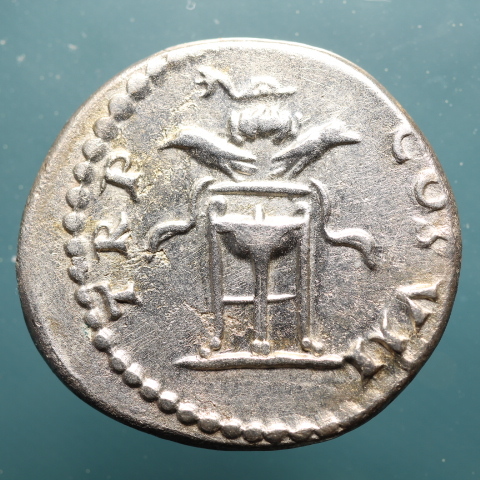
Are we so sure they're ravens? Instead might they possibly be hands? Hmm.
If it's ravens, it's gibberish, a hodgepodge compilation of secondary attributes, exuviae of Apollo, according to Mattingly, in other words, discarded baggage. If it's hands, it's practically a diagram: Lift cover (a), lay wreath (b) in brazier (c), close lid and allow to smolder. The wreath in the diagram is shown sideways because it is being laid to rest, and what have been identified as fillets might actually be, in my opinion, tendrils of smoke.
All of the authorities in the references quoted above this article say ravens. Ravens (BMC), ravens (RIC 1st), ravens (RIC 2nd), and ravens (RSC). But I say hands, left and right, thumbs above and fingers below, a little knob at the wrist where the arms have been artistically truncated. Thanks to the wonderful internet I have taken the opportunity to examine several other examples of this coin. My determination after looking at maybe a dozen or so is that sometimes it looks more like ravens than hands and sometimes it looks more like hands than ravens. However, in no instance could they not be hands and in no instance could they not be ravens. Could it be that the engravers were instructed to leave things ambiguous, sort of a duck or rabbit situation? I tend to doubt that.
My overriding principle, when writing this blog and trying to decipher the meaning behind the images on the coins in the coll., is that what seems mysterious and puzzling to me wouldn't have seemed at all mysterious to the target audience. All of the members of that audience, each Roman singularly and collectively, would have looked at the coin and immediately thought "some of Apollo's random stuff" or else "wreath-replacement ceremony," one or the other but not both. None of them would have been confused even for a moment. To them there would have been no ambiguity and their collective opinion would have been unanimous. Future numismatists might look at the bearded man on the penny and debate whether it's Abraham Lincoln or Rutherford B. Hayes; for us right now, we don't even have to think about it. That's really important to keep in mind. Whether you or I see ravens or hands is a matter open for debate, but the truth lies in one identification or else in the other and not in both.
So what is it here, duck or rabbit, ravens or hands? I'm going with hands. In my opinion, this reverse depicts a specific ceremony familiar to the Romans. Every year throughout all of their lives they would have seen it performed (possibly even participated by wearing the mark of ashes), from one emperor to the next, in uninterrupted progression, and now it's Domitian's turn. Domitian represents Continuity.
In the regular issues struck at the same time as this commemorative issue, the reverse inscriptions contain the phrase DES VIII, destinatus VIII, already designated for an eighth consulship, continuity. And that is precisely what this reverse illustrates--let me say it again--Domitian represents Continuity!
* * *
N.B. Alert graduates of kindergarten as well as people with five fingers per hand may have noticed that I jumped from RIC 3 to RIC 5, skipping the RIC 4 reverse, the throne holding the thunderbolt (an actual pulvinar for a change and the one tying Domitian to Jupiter), and are probably wondering, What the heck is going on here? My answer to them, Hey, if I owned one of these coins I would talk about it, but since I don't, I can't (house rules). This particular coin is on my A-list, so when a nice example comes up for sale I will try to acquire it, and then I will be able to write about it. Fortunately RIC 4 isn't vitally necessary to the point I am trying to make about this topic. Here are the other four coins one last time--




David Atherton suggests that this special issue was struck "as payment to the legions whose loyalty he needed." That seems credible to me. But what about the chronology of this issue?
That there are titles inscribed on the coins of the regular issues of 81 that are not present on this one (such as PONT or P M and DES VIII) has convinced others that this issue came first. This opinion was put forward by Mattingly and Sydenham; however it was not repeated by Carradice and Buttrey, who stood neutral on the subject. I certainly am not convinced. I hope that this series has provided more proof that Mattingly's timeline isn't correct. As I have stated in my previous blog article, this "Group 1" issue wasn't the first issue but a commemorative one celebrating the late awarding of TR P.
In conclusion, the reverse inscription TR P COS VII, stood for the Senate's authority (COS VII) combined with the people's ancient tribal authority (TR P), the Senate and people together, SPQR. It was a reminder to everybody of Domitian's constitutional authority. Possibly most especially to the troops (Atherton).
Next: Haven't decided yet, but probably something interesting about a provincial coin.

